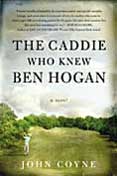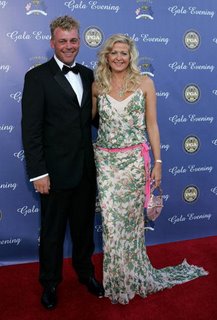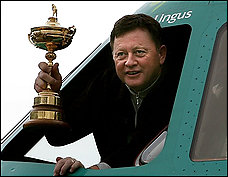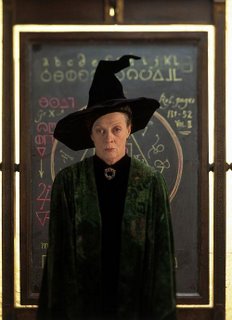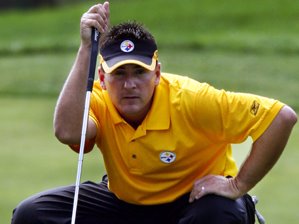Since forming his own design firm in 1997, Colorado’s Jim Engh has won four “best new course” awards from Golf Digest, been named “Golf Architect of the Year” in 2003 (ahead of such luminaries as Fazio, Dye, Jones and Doak), built a reputation for getting world class work done on time and under budget, landed one gorgeous site after another on which to build yet another epic layout, and has developed a legion of loyal fans not just in Colorado and former home North Dakota, but all around the country.
Yet somehow the golf industry and fans actually underestimate Engh and fail to truly appreciate why he is such solid designer.
You read correctly. Underestimate the winner of multiple best course awards.
Because Engh has had gorgeous canvases on which to work - pristine, unspoiled North Dakota and gorgeous Colorado Canyonlands, and scenic Northern Idaho mountain tops - the uninitiated attribute his success to the superficial. “He’s great because he has the most postcard holes?” queries one player meekly. “It’s really pretty, if a little wild…” he trails off, speaking of Lakota Canyon Ranch, a runner up for Best New Public Course in 2005.
Well Jim Engh is already an epic golf course architect, but not because his courses are “another pretty face.” Fossil Trace Golf Club in Golden, Colorado, routed around 64 million year old fossil monuments might never have become a golf course and archaeological treasure without his tireless efforts to offer concessions to environmentalists. The Golf Club at Redlands Mesa might be far more ordinary instead of a quintessential example of world-class green settings and ingenious routing. The Club at Pradera (on which Engh owns a home adjacent to the 16th fairway with his wife Monie and two kids, Brian (10) and Bailey (8)) may be the best private course designed in 2005 due to its collection of unbelieveably tempting par-5s and Pinehurst-like greenside chipping swales.
Yes, I think Engh will be one for the ages when all is said and done, but his secrets are “lines of charm,” “trapdoors and hidden staircases,” and “muscle bunkers,” not merely virgin North Dakota, pristine Coeur D’Alene, Idaho and incomparable Colorado. The result is fascinating golf courses loaded with options and refreshingly innovative routings (try five par-3s and five par-5s frequently). Only then can you add in the jaw-dropping natural settings especially gorgeous green settings a la Mackenzie and Engh’s penchant for making the most of the routing process and well, we have a monster on our hands. Deciding which Jim Engh course to play is like deciding between a chateaubriand and the double lobster tails.
FROM THE CRADLE TO THE SUMMIT
Jim’s introduction to golf was not pleasant. “I crashed my first golf cart when I was two years old.” Jim’s dad was a John Deere dealer who sold to course builders and helped build a local nine hole course, so Jim was on golf courses since leaving the cradle. “Well, Dad was playing and I hopped behind the wheel and hit the gas. I still don’t know how I could have done it, I was so small. The cart rolled over on top of me.”
It was a frightening crash. The cart crushed one of Jim’s kidneys and his life was in the balance for several days. “I was lucky though. I got up from my deathbed.” To this day, he still only had one kidney, he notes grimly.
Despite this particularly negative introduction to the game, Jim kept playing and studying golf and golf architecture. After all, if there is a wall that feels good against your head, it’s golf. Fellow architect and a buddy since Engh’s college days, Tim Nugent remembers an epic moment shared with his life long-time friend.
“In 1985, my dad hired him out of college and he helped us with Golf Club of Illinois before I had to go back to Arizona State for school. So we took a road trip together that summer to the U.S. Open at Oakland Hills. We jumped in my mom’s black ’79 Biarritz (the Oldsmobile, not the golf hole), blew out some carbon and stood right next to T.C. Chen as he did the infamous double hit” Nugent recalls. But timing was everything and Nugent and Engh grabbed a bit of history as well. “We snagged the divot Chen took before anybody was any the wiser and brought it back to the office in a film canister. We didn’t keep it or sell it. This was waaaaaaaaaaaaaaaaaaay before eBay you know.”
Other early memories were comical. Award winning architect Jeff Brauer remembers one colorful moment. “I first met Jim as a summer associate for Bill Kubly. You could tell he was a “gunner” (Kubly’s term for an up and comer) back then, but he was also green as peas. Once he left one of Kubly’s drafting tables in a pickup truck overnight in a rainstorm ruining it!”
Nevertheless, the folksy, humble, stand-up Jim survived the episode, taking it as a learning experience. “Happily, we all have a good laugh about it now.”
Jim worked with a wide variety of excellent designers in these heady, halcyon years. From 1987-1991, he worked for British design firm Cotton Pennick as its Director of Golf Course Design and Construction. The already worldwide presence of the firm (over 300 courses in more than 30 countries) was increased when International Management Group acquired the firm. They sent Engh to many far-flung corners of the globe – from Japan with great Japanese pro Isao Aoki to the European continent with Hall of Fame Golfer Bernhard Langer. From Joe Finger and Pete Dye to the Chinese and the Thai, Jim has designed everywhere across the Northern Hemisphere save Africa. Pretty good for a guy raised in North Dakota with a B.S. in Landscape Architecture from Colorado State. After a few trips to the UK to deeply study the great holes and courses there, Jim decided to form his own firm in 1991.
LINES OF CHARM
The foundations of Engh’s design philosophy are based solidly on the great design features of the great U.K. courses, which he has studied extensively (even though Engh is still a modernist and moves an average of 300,000 – 400,000 cubic yards of earth per design). Like Alistair Mackenzie, Engh eschews the doctrine of framing (where the player is spoon fed what to do on the tee box and responds to the dictatorial will of the architect) and instead keeps the direct line to the hole playable, even tempting, but perilous as well. Like Mackenzie he breaks up the direct line of play to the hole with hazards and creates the line of charm, a perilous but achievable short cut that requires perfect planning and execution. There is a boatload of danger right squarely in the direct line of flight to the target. Meanwhile, the other side of the playing field is wide and welcoming, but a longer way round. The player gets to pick how to play the hole – according to his talent and greed.
Realizing that Mackenzie was right, Engh gleefully delivers fascinating holes that are just as strong in Northern Michigan as they are in Canyonland, Colorado. The results translate best in Engh’s risk-reward par-5s. Many are short – reachable in two by many – but misses are punished mercilessly. “I’ll give a player a shot to reach a green in one shot less than regulation, but I sure won’t help him or make it easy!” he adds with an almost scandalized look as I note the par-5 green at 18 at Fossil Trace is not designed to be overly receptive to a long fairway wood approach. “If they want a putt for eagle, they have to hit two great shots to earn it.”
“I also love short holes” he continues smoothly. “There are a lot more options for all players, regardless of their skill level. I especially like a short par-5 to finish the round.” For example, Engh brings Fossil Trace, Red Hawk Ridge, and his private triumph and home course, The Club at Pradera to a crescendo with short par-5 finales.
“The shorter the hole, the more sex appeal I can add in terms of design features to make the hole interesting. Long par-4s can get dull. The shorter ‘in between-length holes,’ you know, short par-5s and par-4s are short enough for amateurs to have a shot at making par, but there is enough danger lurking that amateurs and experts alike stand as much chance of making six as they do three” he finishes excitedly.
Engh also has some Old Tom Morris and A.W. Tillinghast in him. Speaking of Old Tom’s design Machrihanish, the Good Dr. Mackenzie wrote in The Spirit of St. Andrews, “Some of the natural greens were so undulating that at times one had to putt twenty or thirty yards round to lay dead at the hole five yards away. These greens have all gone and today one loses all the joy of outwitting an opponent by making spectacular putts of this description.”
Well, Old Tom would be heartened to see some of Engh’s creations. Engh, like Morris and A.W. Tillinghast (at places like Winged Foot and Baltusrol) and like Mackenzie (at Pasatiempo and Crystal Downs), incorporated wild green undulations, for example, Fossil Trace and shaved greenside chipping swales instead of rough, most notably at Pradera. Engh’s greens have so many features and unique hazards, the green complexes are often a hole in and of themselves and the hole is frequently only beginning upon reaching the putting surface.
If there is a common theme to many of Jim’s holes, everything is a bowl. Fairways frequently have sidewalls that keep erratic players reasonably in play. With sidewalls at the green complex, there are a lot of player friendly bounces. “That’s where the payoff is” says Engh. “Not only does it keep people in play, but it creates options because there is more than one way to get on the green or get one close.” He is right. Errant shots gather close to the hole and result in a birdie putt instead of a difficult chip or wicked short-sided pitch.
If there is another common theme, Engh builds some of the greatest showstopper par-5s in the business. His three shotters are always filled with options and myriad angles of attack. Yet, like Mackenzie, the direct line of the hole is fraught with peril. Holes are tempting to experts but requiring pinpoint execution, but fair for average players. Like Alistair Mackenzie’s great par-5s, the timid golfer can play the three shotters by taking the long way around, but they lose strokes by avoiding risks.
The result of Engh’s cumulative philosophy is an array of challenging and interesting courses that place heavy emphasis on smart strategic play as well as solid execution. As a result, Engh says more in 311 yards than most architects say in 450.
TRAPDOORS, HIDDEN STAIRCASES AND MUSCLE BUNKERS
Engh also designs with a unique artistic voice. His originality shines through in his trademark bunkering style (called “muscle bunkers” by the team) and in the unexpected twists in his designs that he calls “trapdoors and hidden staircases.”
“I was in Ireland touring Donegal Castle” Engh recalls energetically. “I had done this particular tour once before, so I slipped away from the main group up a back staircase and started exploring on my own. I found all sorts of trapdoors and hidden stairways and secret passages.”
“Golf courses are the same” he continues, his eyes flickering with enthusiasm. “Each time you play a course you learn another secret about it…some way to play avoid a hazard or some bump off which to play a creative shot. You learn something new every time you play a great golf course. So I incorporate the concept in my design and it makes for many exciting playing options. My goal is to create a course that you can play every day and never get bored and play every day and find some new way to attack a hole. Some people get frustrated, but it’s only because they are seeing something new and they haven’t figured out how to successfully play the hole. Most people like the course more with lots of options and interesting windows and trapdoors.”
Take, for example, the par-5 15th at Fossil Trace. The rock wall seen in the distance from the tee box appears to be the end of the fairway:
[IMG]http://i42.photobucket.com/albums/e302/jaygolfusa/fossiltrace006.jpg[/IMG]
However, behind the rock wall is a hidden sliver of fairway which meanders its way to the back of the green and sidewalls to allow long shots to carom back toward the center of the green. Seen below, the green can be attacked from the front and rear.
[IMG]http://i42.photobucket.com/albums/e302/jaygolfusa/fossiltrace007.jpg[/IMG]
“That’s something I try to accentuate on every course and on many shots” Engh instructs in the voice of a master of his trade. “There is always more than one way to get close to the hole.”
Engh also has a totally revolutionary and unique style of bunkering. – fanciful sperm-cell shaped squiggles set six to ten feet beneath heaving bumpy high-sloped rounded mounds that resemble a flexed bicep – hence Engh’s moniker “muscle bunkers.” The 18th at Fossil Trace is pictured below.

“I see a lot of Dick Nugent in Jim’s work now.” says Brauer thoughtfully, “But he has finely developed his own style. This starts with his philosophy of great plans and this extends to the general scale of the golf course and the general look, but with a fresh new concept and styling and bigger, deeper bunkers.” Tim Nugent agrees. “Sure, Jim gets great sites, but he also makes the most of them with great routings.”
To ice the cake, Engh has also built a reputation for coming in on time and under budget every time. Engh’s secret? “I’m stubborn, I have a hard head and I don’t listen to naysayers” he states mischievously. After the tableshares a hearty laugh, Engh continues. “The way I translate what I want to my shapers is through detailed contour drawings.”
Engh pauses for a moment, becoming a little nostalgiac before speaking. “One of the reasons why I liked Mike Strantz so much” he recalls both fondly and sadly “is that he communicated to his design team through sketches of the holes. I do something similar with my contour drawings. I do my contour drawings and luckily that form is the typical construction form and they can build it without many changes. I push the envelope on paper because if you have to change it after, that’s when jobs start to get expensive. I spend about 1000 hours each job on the contour drawings” Engh summarizes. “Then, it’s in the hands of my shapers.”
There is an old adage in the golf course construction business – much success will depend on the accurate interpretation and creation of the architect’s wishes. Although Engh plans out every single contour of every single yard of every single hole of every single course, his team of Mitch Scarborough and Tim Hartnett and the team of shapers must have the same DNA and neural synapses as Jim. “Mitch reads my mind and Tim is talented and enthusiastic. I’m the luckiest guy in the world to have the team around me that can take my contour drawings and turn it into a golf course.” Hartnett, a dead ringer for Pittsburgh Steelers quarterback “Big Ben” Roethlisberger, rivals Jim for lifelong passion for golf course architecture. How devoted is Tim? “When I broke my arm in high school playing basketball, I doodled golf holes on the cast. My doctor was astounded. He kept half the cast, my mom kept the other half.”
Jim is so loyal to his staff, when one shaper was tragically killed driving home in a snow squall, he dedicated a greenside plaque on the 8th hole at Red Hawk Ridge to his memory.
JIM’S COURSES
With a solid foundation buttressing his work, and a fiercely loyal team backing him, Engh got his break when fate paired him with Dave Liniger, owner of Re/max playing in a practice round for a local tournament. They became friends, and Dave asked him to design The Sanctuary Club on a 220 acre mountainous plot of land that tumbled through the high desert near Castle Rock and offered panoramic views of the valley floor hunders of feet below. When playing Sanctuary, movie buffs who saw The Lord of the Rings: The Return of the King may be reminded of the view from the high towers of the white city of Minas Tirith overlooking the plains below. Engh’s first solo design, it won “Best new private course.”

(above, the first tee at Sanctuary is not for the heightrophobic.)
Sanctuary has only two members - Dave and his wife Gail. Rumors quickly circulated about the course. Internet urban legend recent spread a hilarious rumor in cyberspace that Liniger had sold the course in 1998 to a group of lesbian women who desired to “turn it into their Augusta National and make sure that no man ever plays there again.” Instead, the course has played host to countless charity tournaments. To date, charities have raised over $33 million through events at Sanctuary.
It’s a miracle the course exists at all. The Linigers battled through tough economic times until the early ‘80s, then had their own wedding delayed horribly when Gail was critically injured in a seaplane crash along with close family friends. It took months for Gail to recover and she proved Doctors wrong time and again who predicted she might never walk again. In 1988 Gail was recognized as one of the top ten women in the U.S. for her outstanding achievements in business, the arts and public service. In 1989 she was named “Entrepreneur of the Year” for the state of Colorado by Ernst & Young and Inc. Magazine. The great course they built as a family is yet another step in their great comeback story. “We didn’t accomplish these things by being brilliant, we did it because we never quit” Dave says pointedly.
It was a difficult site, but the things that make Sanctuary difficult topographically also make it exciting to play. The course also helped forger Engh’s reputation for “on time and under budget.” The land was purchased in September and construction began the next February. All in all, the entire course was conceived and built in about a year.
Since then, no other architect has a higher ratio of top awards to courses designed than Engh. Hawktree Golf Club in Bismarck, a welcome homecoming for Engh who spent many childhood years in nearby Dickenson, was runner up for Best New Public course in 2000. (Engh has returned to Dickinson to play in his local club championship for over thirty years.)
Next, Redlands Mesa won Best New Public Course in 2001, Tullymore won Best New Upscale Course in 2002, and Black Rock won Best New Private Course in 2003. That’s quite a tri-fecta.
Lakota Canyon Ranch and Pradera were both finalists in 2005 and made strong runs at the top accolades. As we go to press, Engh is finishing a new private course at Reynolds Plantation and starting a course in Napa Valley, California. Engh is even designing a new nine at Carne, the legendary plot of dunes landing the “Bloody Forelands” of northwest Ireland where Eddie Hackett built and epic links. That’s fitting. He brought the UK back here…now he gets to give back to the UK.
Engh’s few critics say the drawback of his moving a lot of earth means that he tends to superimpose golf holes on the land, rather than work with what the land offers. This critique, while true on its face, belies the actual reality. First, despite moving a great deal of earth, Engh usually reserves the bulk of the building for elevated tee boxes, while the fairways and greens play through the natural lay of the land. He may make some low areas lower and build many pulpit tees, but Engh, like Mackenzie, does not overpower the excellent natural settings he has been blessed to work on. Engh actually preserves what the land had originally, and also promotes the history and content of each plot to give a course a flavor of its natural setting.
Critics also decry his work as unwalkable, but that’s only Sanctuary and Lakota, both of which would be remedied by simply adding walking paths.
As a result, Engh resonates with players of all handicaps. Steve Josephs, a three handicap, is a veteran of multiple Engh designs. “Jim makes you think around the course. He’s demanding to lower handicappers because the drives require solid thought and strategy. You just can’t bang a driver out there. But he’s also friendly to higher handicappers because of the bowl shaped greens and fairways which bounce the ball back into play. I also love his elevation changes and undulations.”
Chris Burney, a bogey golfer from Texas also ranks Engh as his favorite architect. “He showed me things at Blackstone I had never seen before. The bunkers were unique and huge, yet the sidewalls and punchbowls helped keep the ball in play and gave everything an “amphitheatre” look. I can’t wait to play another Engh course.”
KEEPING IT REAL
If Mike Strantz parallels Jeff Buckley, then Jim Engh is a young Led Zepplin. He has raw power, vibrant imagery and fearless style – no matter what the detractors say. You’ve never seen anything quite like this, but its diamond-hard foundations are the strategies of golf architecture we have embraced for centuries. He bequeaths substantive design features of real value to players and students of the game alike brought to life with vivid clarity. Moreover, his unique energy and fresh interpretations are palpable and infectious. Thankfully, they are also playable for high handicappers.
His par-5s especially may arguably be the best being designed today. The panoramic sweep and full blown grandeur of holes like 7, 16 and 18 at Pradera on the private side, his soon to be built three greened 18th at Reynolds Plantation and his amazing templates for the craft at 13 at Redlands Mesa and 18 at Lakota Canyon Ranch on the public side are heart-pounding.
As if the architectural talent weren’t enough, Jim plays to a 2.3 handicap index and competes in long driving tournaments, pounding out 300 yard lasers like a human Iron Byron. Some friends boast Jim could shoot 75 with a rake and an Easter egg.
Nevertheless, through all his successes at just his mid-40s, Jim is remarkably human, compassionate and generous. He has a great sense of humor. He took perverse delight in making me play the ball that embedded in the fossil monument at Fossil Trace’s famous twelfth hole. He gleefully prodded me 12 feet up the sandstone monument with my own ball retriever to “play the ball where it lies, Jay.” Also after I hit in the monument he commented “you couldn’t do that again in 64 million years” after I missed by five feet he impishly added “that’s the best shot you’ve hit in the last twelve holes.”
[IMG]http://i42.photobucket.com/albums/e302/jaygolfusa/P8270023.jpg[/IMG]
Oops! Once in 64 million years – your author’s ball embedded in Fossil Trace sandstone monument.
[IMG]http://i42.photobucket.com/albums/e302/jaygolfusa/P8270026.jpg[/IMG]
“Play the ball where it lies, Jay!”
Engh’s greatest source of pride is not his work, but his family; his wife Monie (pronounced “MOE-knee”) and children, son Brian, 11 and daughter Bailey, 8. “We have a house on Lake Coeur D’Alene [where he built Black Rock] and every year in the winter we go to Hawaii. I never play any golf. Instead it’s two tanks of scuba diving in the morning, then Mai Tais by the pool with Monie and the kids all afternoon” he notes with a serene smile, as though he’s momentarily back there.
Jim’s mom, who sadly passed away last December, is still his hero. “Jay she was a remarkable woman. I owe so much to her. She always tried to teach me to be humble and not be self-aggrandizing. If she ever heard me bragging about any of the honors I’ve been really lucky to earn, she’d be really disappointed and would shake her finger at me! She was wonderful and wise.”
Jim lets his hair down as well. “Monie and I are huge Van Morrison fans. I’ve seen him everywhere from the UK and Ireland to California to Colorado” Engh declares with the most rabid loyalty lighting up his face. He still goes to Red Rocks and the Odgen Theatre for many concerts. He even moshed with his 11 year old son during “The Last Rock Show” at a concert of rock band Bowling For Soup. “It was Brian and Bailey’s first concert” he recalls fondly.
Nicknames are part of the comradery of the Engh design team. “Jim is known across the globe as ‘Two mops’ because he spilled beer in an Irish pub so badly they needed two mops to clean up after him” chortles Tim Hartnett. For the record, Tim’s nickname is “Flipper” because of his habit of flipping the club in his hand five times before teeing off and three times before hitting other shots. He is even good humored when his friends playfully serenade him with the old TV theme song - “They call him Flipper! Flipper! Faster than lightning.…” But that’s what it means to be a part of the Engh team - lots of self-effacing humor, lots of plain old fashioned hard work, and “thank yous” all around, whether they’re from “Two Mops,” “The Dakota Kid,” “Gunslinger” or just plain “Jim.”
